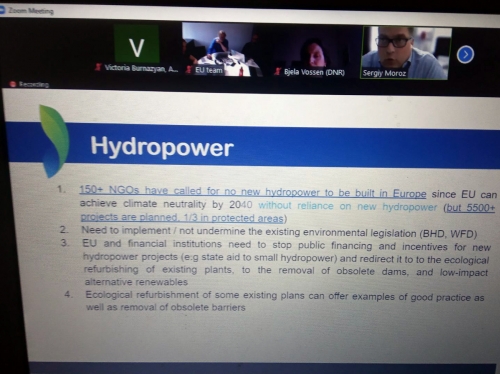

Europe intends to develop renewable energy, especially solar and wind energy, to reduce greenhouse gas emissions in the energy sector, and to reduce dependence on Russian energy sources. 71% of greenhouse gases in Europe come from the energy sector. Europe plans to increase greenhouse gas emissions by 55% by 2050 as part of its European Green Deal.
The development of renewable energy will bring with it risks to the environment.
The European Environment Bureau (EEB), Europe's largest network of environmental organizations, is developing a policy on how the EU can use the findings of "PAC Scenario results" to develop renewable energy in Europe that does not harm the environment but also has a positive impact.
On May 3, “EEB Policy Brief: Policy measures towards nature positive renewable energy in the EU using PAC scenario results" draft document was discussed with EEB non-member NGOs remotely. Victoria Burnazyan, Vice President of EcoLur Informational NGO, also took part in this discussion.
According to the document, one of the risks for the development of solar and wind energy is the involvement of large plots of land in the EU Green Deal to achieve geopolitical goals. This could have a negative impact on biodiversity, whereas the sector could compete with food production if appropriate guarantees were not applied. Demand for raw copper, zinc, silicon, lithium and neodymium will increase for the production of new plants, turbines, solar panels and other necessary assets. Metal extraction and recycling can lead to the destruction of plant habitats leading to the loss of local biodiversity.
Other issues of concern, such as soil pollution, erosion, water regime change, and gas or dust emissions. Heavy metal contamination caused with mining operations can cause long-term acid contamination of mines, groundwater, wetlands, and other water systems. In the case of bioenergy, there will be massive CO2 emissions during power plant biomass burning, as well as deforestation, which is also detrimental to biodiversity, soil and ecosystems.
The construction of the plants will lead to an increase in waste in both the mining and energy sectors. For Europe, the installation of 100,000 new wind turbines by 2050 will generate up to 730,000 tonnes of e-waste. The world's 3,500 large-scale mining companies produce more than 100 billion tons of solid waste per year, making mining waste the largest waste stream in the world. Therefore, rational use of resources is needed to reduce the need for raw materials. Impacted communities will be affected.
• The main recommendation mentioned in the document is energy-sufficiency (reduction of energy use) and efficiency (elimination of energy waste).
• The following proposals for wind, solar, hydropower and bioenergy sectors were discussed at the meeting.
Wind
· Energy efficiency must come first (integrate new renewables in comprehensive planning, that include the maximization of EE)
· Exclude protected areas (in land and of-shore) for installation (no go areas)
· this must include surrounding areas
· No disruption criteria should be applied when installing wind turbines
· GPP must be used to improve material and social sustainability of the installations
· Go to areas should be prioritized, where very limited permitted procedures would apply,
· Local communities must be involved in planning and in ownership
Photovoltaics
· Photovoltaics should never come at the cost of food or feed production
· In some cases, though, agri-PV could play a positive role for agriculture production
· Under certain criteria agri-PV could be a positive driver for improving soil quality and biodiversity in degraded
· Go to areas should be prioritized (industrial areas/highways)
· Roof installations should always be favored (consent by silence)
· GPP must be used to improve material and social sustainability of the installations
· Local communities must be involved in planning and in ownership
Hydropower
· 150+NGOs have called for no new hydropower to be built in Europe since EU can achieve climate neutrality by 2040 without reliance on new hydropower (but 5500+ projects are planned, 1/3 in protected areas)
· EU and financial institutions need to stop public financing and incentives for new hydropower projects (e.g state aid to small hydropower) and redirect it to the ecological refurbishing of existing plants to the removal of obsolete dams and low-impact alternative renewables
· Ecological refurbishment of some existing plants can offer examples of good practice as well as removal of obsolete barriers
Biomass
· Full compliance with cascading principle
· only biomass sourced from waste that has no alternative use or value should be considered as sustainable
· No biomass directly sourced from forest
· Proper accounting of emissions associated with burning of biomass
· Solid biomass of residential and tertiary heating should be phased out by 2045
· Negative emissions technologies (Carbon capture Storage and Use) don't make bioenergy sustainable
One of the proposals is to raise the bar of environmental protection for energy project permits to overcome environmental problems without compromising the speed of deployment of renewable energy plants in the EU. The transfer of renewable energy should not be an excuse to add mining raw materials. Instead, we need to move to a model based on energy and material needs reduction, reuse and recycling.
May 06, 2022 at 12:51
